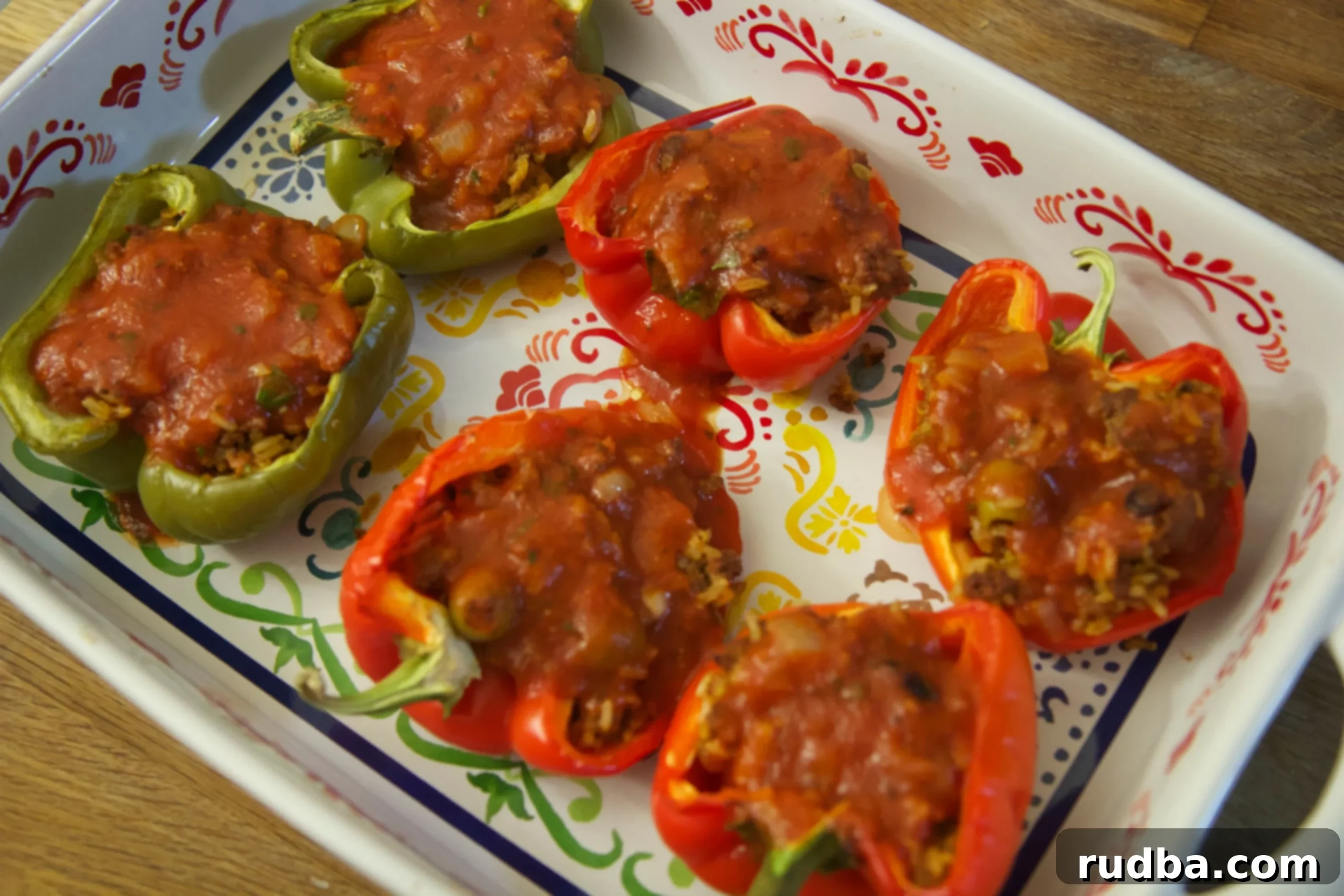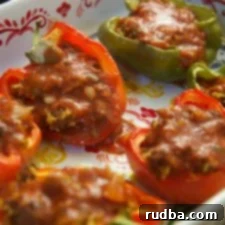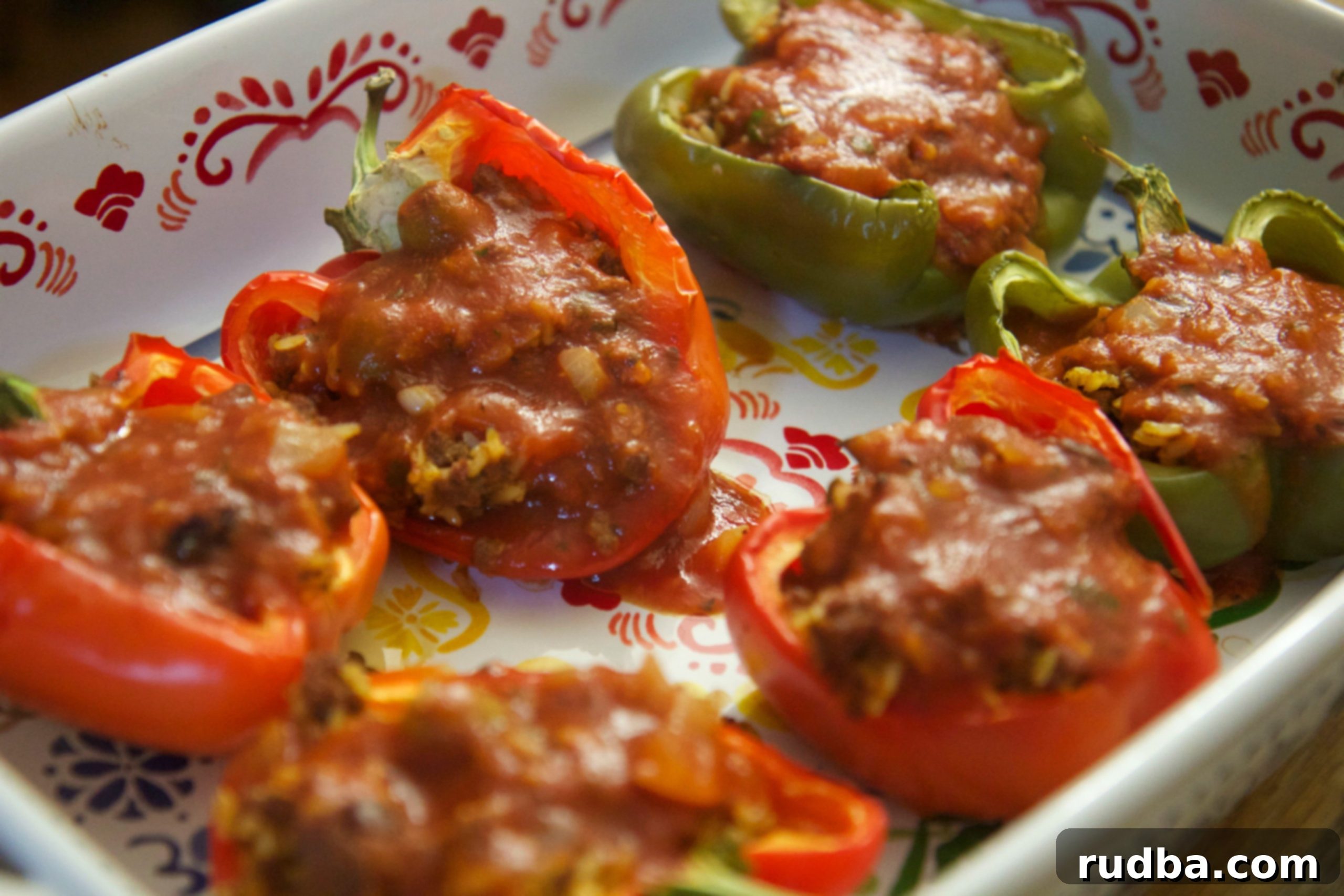Authentic Cuban Stuffed Bell Peppers (Ajíes Rellenos) with Savory-Sweet Picadillo

Growing up, my relationship with stuffed bell peppers was, to put it mildly, complicated. As a child, the idea of an entire vegetable as the main course for dinner often felt like a culinary chore. While other kids dreamt of pizza and pasta, I secretly wished those bell peppers would magically transform into something else. It took years, and a significant shift in my palate as an adult, to truly appreciate the humble yet versatile bell pepper as a delicious vessel for a hearty meal.
That transformation happened when I discovered the magic of **Cuban Stuffed Bell Peppers**, or *Ajíes Rellenos*. This dish is a game-changer. It took me from a skeptic to an enthusiast, proving that a vegetable-centric meal could be incredibly satisfying and flavorful. It’s a perfect weeknight dinner solution: straightforward, remarkably easy to prepare, and incredibly versatile. If you’re watching your carbohydrate intake, the rice in the filling can even be adjusted or omitted entirely without sacrificing much of the deliciousness. This recipe isn’t just food; it’s comfort, flavor, and a touch of Cuban heritage all rolled into one delightful package.
What Makes Cuban Picadillo So Irresistible?
At the heart of these delightful stuffed peppers lies the iconic Cuban picadillo. While many Latin American cuisines boast their own version of picadillo, the Cuban rendition distinguishes itself with its unique blend of sweet, savory, and tangy notes. It’s a rich, flavorful ground beef mixture that features a trio of unexpected ingredients: briny Spanish olives, sweet raisins, and a blend of aromatic spices. These elements create a complexity that is deeply comforting and utterly delicious.
The finely chopped onions and garlic form the base of a classic Cuban sofrito, which is essential for building flavor. Bay leaves contribute an earthy depth, while a touch of *sazón* (an optional but highly recommended seasoning blend common in Latin American cooking) adds a beautiful color and a savory kick. The dry white wine (vino seco) deglazes the pan and introduces a subtle acidity, enhancing the overall profile. But it’s truly the sweet plump raisins against the salty, pungent olives that create the signature Cuban picadillo taste – a harmonious balance that will leave you craving more. This filling is not just for peppers; it’s fantastic in empanadas, over rice, or even as a standalone dish.

The Perfect Stuffer: Bell Peppers
Bell peppers are more than just a colorful shell for our savory filling; they are an integral part of the dish’s flavor and texture. Their natural sweetness, especially in red, yellow, and orange varieties, complements the robust picadillo beautifully. Green bell peppers offer a slightly bolder, more earthy flavor that some find enhances the beef. When baked, the peppers soften to a tender, yielding texture, becoming infused with the rich juices of the filling, rather than remaining crisp and raw.
Beyond their culinary appeal, bell peppers are nutritional powerhouses, packed with Vitamin C, Vitamin A, and antioxidants. Using them as a vessel for a protein-rich filling like picadillo turns a simple vegetable into a well-rounded and wholesome meal. Their sturdy structure holds the filling perfectly, making for an attractive and satisfying presentation at the dinner table. Pre-baking the peppers ensures they are tender enough to cut through easily once stuffed and fully cooked, preventing them from being too firm or undercooked.
Crafting Your Cuban Stuffed Peppers: A Step-by-Step Guide
Creating these flavorful Cuban stuffed bell peppers is a straightforward process, but paying attention to a few key steps will ensure a truly delicious outcome. Follow these tips to master this classic dish.
Choosing and Preparing Your Peppers
- **Selection:** Opt for firm, fresh bell peppers that are vibrant in color and feel heavy for their size. Any color will work, so choose your favorite or a mix for visual appeal.
- **Preparation:** Carefully slice off the tops of the bell peppers, then remove all seeds and white membranes from the inside. A small paring knife works well for this. Rinse the peppers thoroughly.
- **Initial Bake:** Don’t skip placing the hollowed peppers in a preheated oven (350°F or 175°C) for about 25 minutes. This crucial step softens the peppers, making them more palatable and ensuring they are tender when the entire dish is finished baking.
The Art of Making Cuban Picadillo
The picadillo is where all the Cuban flavors truly shine. Building it properly ensures a rich, complex filling:
- **Browning the Beef:** Begin by cooking the ground beef in a skillet with a little oil over medium-high heat. Break it up with a spoon and cook until it’s completely browned, about 10 minutes. This step is essential for developing a deep, savory base. Drain any excess fat to keep the filling from being greasy.
- **Building the Sofrito:** Once the beef is browned, add the finely chopped onions and minced garlic. This is the start of your sofrito, a flavor base integral to Cuban cooking. Sauté these aromatics for a couple of minutes until the onions soften and become translucent.
- **Seasoning:** Now, introduce the magic of the Cuban spices. Add the garlic powder, onion powder, oregano, and bay leaves. If using, stir in the optional sazón packet for extra color and flavor. Season generously with salt and pepper to taste. Cook for another 2 minutes, allowing the spices to become fragrant.
- **Adding Liquids and Simmering:** Pour in the vino seco (dry white wine) to deglaze the pan, scraping up any browned bits from the bottom – these are packed with flavor! Stir in the tomato paste and tomato sauce, then add about ½ cup of water. Give it a good stir, cover the skillet slightly, and let the picadillo simmer for about 25 minutes. This simmering time allows the flavors to meld beautifully and the sauce to thicken slightly.
- **The Signature Cuban Touch:** After simmering, stir in the Spanish olives and raisins. These are the star ingredients that give Cuban picadillo its distinctive savory-sweet-tangy profile. Continue to cook for an additional 5 minutes, allowing the raisins to plump and the flavors to fully integrate.
Stuffing and Final Bake
Once your picadillo is ready, remove it from the heat and gently fold in the cooked rice. This creates a wonderfully substantial filling. Carefully spoon the rice and beef mixture into each pre-baked bell pepper, filling them generously. For extra moisture and flavor, pour some of the remaining picadillo sauce or additional tomato sauce over the stuffed peppers before placing them back into the oven.
Return the stuffed peppers to the oven for another 25 minutes. This final bake allows the peppers to finish cooking, and the flavors to truly infuse into every bite. The aroma that will fill your kitchen during this stage is simply divine!

Cuban Stuffed Peppers
Save RecipeSaved Recipe
Pin Recipe
Rate Recipe
Print Recipe
Ingredients
- 1 lb ground beef
- 1 small onion
- 2 garlic cloves
- 2 bay leaves
- ½ packet of sazon, optional
- ½ tsp garlic powder
- ½ tsp onion powder
- ½ tsp oregano
- Salt and pepper to taste
- ¼ cup vino seco, dry white wine
- 1 tbsp tomato paste
- 3/4 cup tomato sauce
- ½ cup water
- 3 tbsp Spanish olives
- 3 tbsp raisins
- 6 bell peppers
- 1 cup cooked rice
Instructions
-
Remove seeds and membranes; rinse peppers and place in a preheated oven at 350 degrees for 25 minutes.
-
In a skillet with some oil cook ground beef for about 10 minutes or until browned completely, stirring occasionally.
-
Add the onions, garlic, red pepper flakes, garlic powder, oregano, onion powder, bay leaves, sazon (optional), season with salt and pepper and cook for 2 minutes.
-
Add the vino Seco (dry white wine) tomato paste, tomato sauce, and some water; cover slightly and let it cook for about 25 minutes.
-
Stir in the raisins and olives and let it cook for an additional 5 minutes.
-
Remove from the heat and stir in the cooked rice.
-
Stuff peppers with rice and beef mixture and pour some salsa over the peppers.
-
Place in the oven for an additional 25 minutes and Enjoy.
Video
Nutrition
Nutrition information is automatically calculated, so should only be used as an approximation.
Additional Info
Like this recipe? Leave a comment below!
